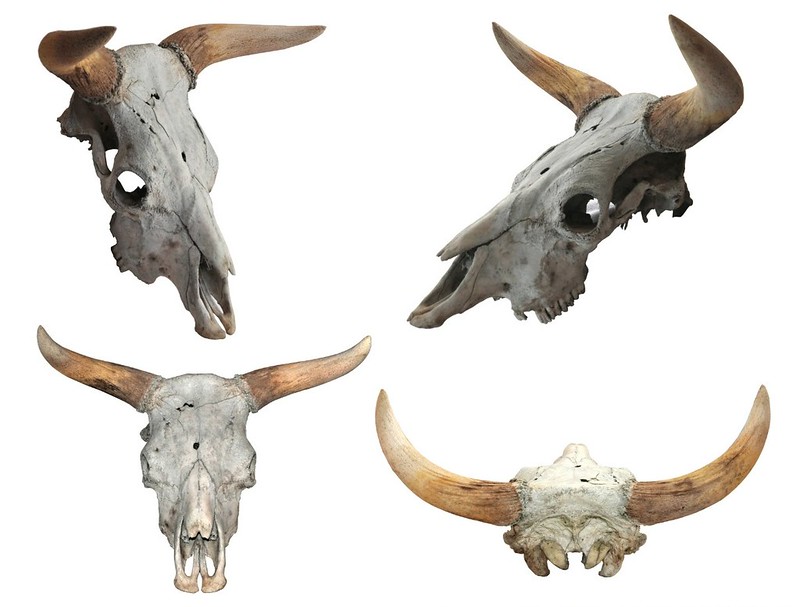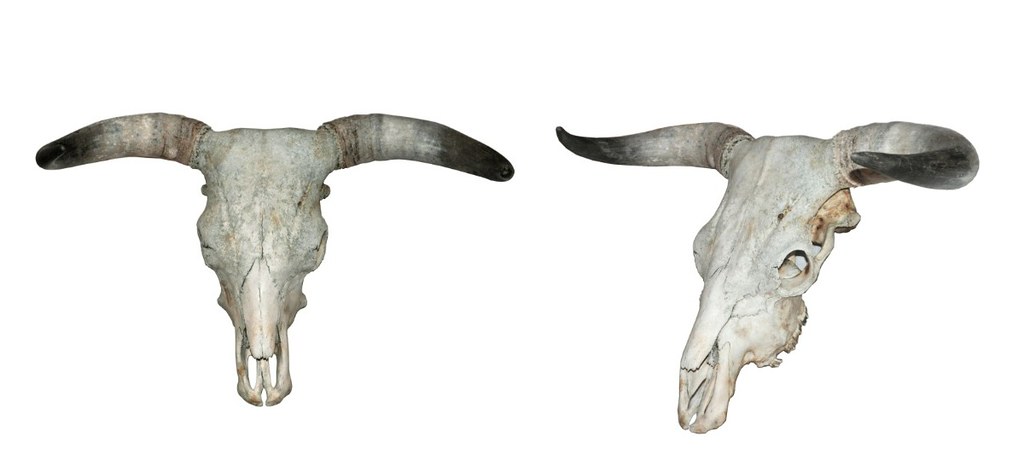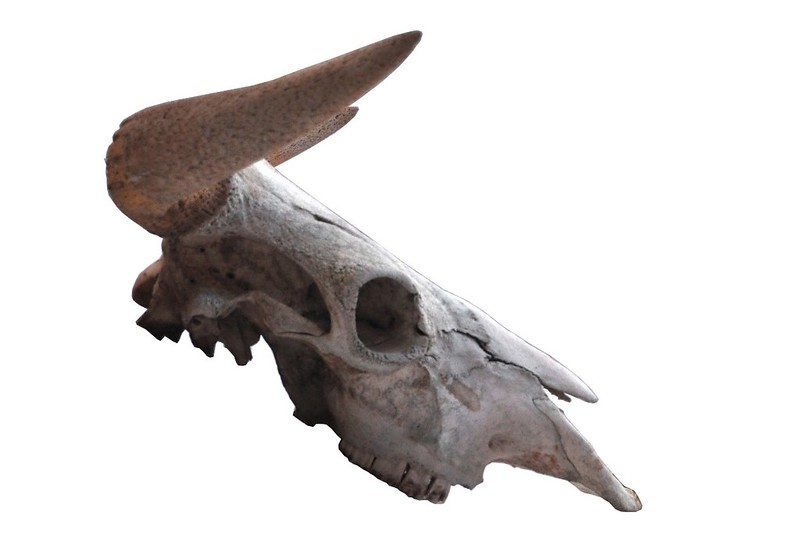As
promised, here is my post on the two Taurus bull skulls from the Lippeaue.
But first,
a little introduction to the bulls the skulls are from.
 |
| "Luca" (Heck x Chianina) Photo © ABU |
The larger
one is from a bull named Luca, he was one of the first cross bulls produced by
the ABU and was Heck x Chianina. He may have been about 160 cm tall at the
shoulders (my calculation based on photos and the actual skull), had a diluted
colour due to its Chianina ancestry and was used as a breeding bull in the
Hellinghauser Mersch herd until he died 3 years ago. He is the father or
grandfather of numerous individuals at Lippeaue, very good individuals like
Lamarck among them, who replaced him as breeding bull.
The second
skull you might already know from my report of my trip to the Lippeaue, it was
one of the skulls I viewed in the field. It’s from a bull called Latino – 50%
Sayaguesa, 25% Lidia, 25% Heck. He was selected out because of his comparably
small size (I estimate a height of 145 cm for him based on photos) and his nervous
and aggressive behaviour (I’m not saying this kind of behaviour is “unnatural”
or exaggerated, but I understand that such bulls are extremely difficult to
handle). He had a quite aurochs-like overall appearance though, and I suspect
that he is the father of this bull I saw at neighbouring Pöppelsche.
And now the
skulls:
Luca
Skull
length (from frontal bone to nasal bone): 49 cm
Skull
length (from frontal bone to premaxilla): 59 cm
Breadth
from eye opening to eye opening: 25,3 cm
Breadth
between the bases of the horns: 23 cm
Horn cores
Length
(outer bow): 63,3 cm
Circumference
at base: 31,3 cm
Span from
tip to tip: 77 cm
Horn sheath
Length
(outer bow): 79,5 cm
Circumference
at base: 34,5 cm
Span from
tip to tip: 70 cm
Maximum
Span: 82 cm
Horn angle
relative to the skull: 80°
Latino
Skull
length (from frontal bone to nasal bone): 44 cm
Skull
length (from frontal bone to premaxilla): 54 cm
Breadth
from eye opening to eye opening: 23 cm
Breadth
between horn bases: 28 cm
Horn cores
Length
(outer bow): 44 cm
Circumference
at the base: 28 cm
Span from
tip to tip: 80 cm
Horn
sheaths
Length
(outer bow): 61 cm
Circumference
at the base: 30,5 cm
Span from
tip to tip: 71 cm
Maximum
span: 85 cm
Horn angle
relative to the skull: 65°
With 65°, Latino’s horn orientation is within the variation we see in the aurochs. With 80°, Luca’s horns are too upright, altough the Vig bull with unusually upright horns comes close.
It was
interesting to see the difference in size and shape between horn sheath and
horn core when I detached them. The horn sheath of Luca adds 25,6% to the
length of the horn cores, while that of Latino adds 38,6%. It adds 23,3% of
thickness in Luca and 27,3% in Latino. Comparing the shape of the horn sheaths
with the cores I realized that the sheaths have a much more pronounced
curvature. Luca’s sheaths resemble the shape of many aurochs horn cores and
curve inwards, but his horn cores are more straight and show almost no curve
towards each other. The same is the case with Latino’s horns and probably every
bovine in the world. I therefore see two consequences: a) aurochs horns were
longer and slimmer at the tips than horn bones indicate and their curvature was
more extreme, perhaps similar to this maronesa bull, b) we should consider that
if an individual has horns sheaths that look like bony cores of some aurochs
specimens, the horns are not identical because its cores would be shorter and
less curved.
The superimposings
with photos of aurochs skulls were very helpful to see differences and
similarities. I did them in lateral (side) view and dorsal view (when the snout
is vertical to the ground). I always took the distance between the caudal end
of the frontal bone and the eye openings as reference since the length/breadth
ratio of the area from the caudal end of the frontal, the imaginary line between
the eye openings and the horn bases in both skulls was the same. It showed me
that not the entire skull is shorter, but mostly the snout. Also, the eye
openings are slightly enlarged in the Taurus bulls, but not much. The skull of
the Sassenberg bull is an exception, which was a really long-snouted and
small-eyed old specimen. Down below you see the amount of skull length reduction
in the two Taurus skulls in respect to the aurochs skulls.
Prejlerup
|
Berlin
|
|
Luca
|
-4%
|
-7%
|
Latino
|
-12%
|
-5%
|
Lund
|
Vig
|
Sassenberg
|
Baikal
|
|
Luca
|
-8%
|
-7%
|
-25%
|
-7%
|
Latino
|
-19%
|
-13%
|
-34%
|
-10,3%
|
According
to Nehring 1886 the usual skull length of the investigated aurochs skulls
varies between 64 and 72 cm. I wonder whether “skull length” means from the
caudal end of the frontal to the cranial end of the nasal or the premaxilla.
Let’s assume the former is the case. The arithmetic mean of the relative length
difference between the aurochs skulls and the Taurus skulls is about 13%.
Increasing the skulls absolute length by the factor 1,13 results in 49,7 and 55
cm. That means that the Taurus skulls are not only shorter but also smaller
than usual aurochs skulls, what isn’t surprising considering that the
individuals themselves were smaller than aurochs (Latino) or had a proportionally
smaller skull (Luca). Also, the nasal bone seems to be
shortened relative to the length of the premaxilla in Luca. Interestingly, the
nasal bone has two bulges in both skulls instead of one proximal bulge as in
the aurochs, what was not visible in the living animals.
Having had
a look at the occipital bone, I recognized that the fossae for the attachment
of neck muscles forming the so-called neck crest in taurine bulls, wisents,
cape and water buffaloes are about as deep and pronounced as in aurochs
skulls. This implicates that the crest in the aurochs was of similar size as in
bulls of less-derived taurine breeds, what simply makes functional sense.
I also did
superimposings with photos of the two bulls in flesh, but they mostly did not
work out well because of the perspective. However, one with Luca in
profile is quite ok, shown down below. It is interesting to see that the eye
sockets protude greatly from the skull in Taurus cattle or Lidia (and probably
most other primitive cattle) and the aurochs, but in the living animal the eyes
don’t stick out that much, so it probably looked the same in the aurochs.
With all
the information the comparisons between aurochs skulls and my skulls I tried to
do a rough reconstruction of an average bull aurochs head. It is based only on
what the bones tell me, and focuses on proportional issues and horn shape. I
increased the skull/snout length by about 15%, slightly increased the horn size
(the relative horn core length of Latino and the Prejlerup skull is identical,
but other aurochs skulls have larger horns) and added the parts of the
curvature that is missing in his horns (I didn’t put much artistic effort into
it, it’s main purpose is to show the proportional differences).















I don't know if this photo of an aurochs skull measurement is of any use to you.I know you seen it before.
ReplyDeletehttp://www.ahobproject.org/Picture_Library/transition/Full_Size/Ilford%20Bos.jpg
Sorry for this delayed comment. I find this subject quite fascinating. Please note that my following questions arise out of great curiosity and interest as a complete amateur, not out of any wish to argue. I was struck in this post by the comment that the bull Latino was culled (?) because of his "nervous and aggressive" temperament. A nervous and aggressive bull is surely more of a wild-type temperament than a more docile animal, is it not?
ReplyDeleteIs the intention in breeding-back European horses/cattle to create a "park" animal which resembles the ancestral wild species physically but can be handled and is not especially dangerous? I suppose that would be the realistic approach in the European context, I have to admit I'm spoiled as I live in Canada where we fortunately have not exterminated our native megafauna, and we retain immense tracts of wild or near-wild lands. :-) Anyway - If there is any intention to recover a semi-wild temperament, have very many people in the rewilding projects worked with both domestic horses and takhis or zebras, for example? (I haven't done that, but I know both dogs and wolves first hand... there are profound behavioural differences between domestic and never-domesticated species which are best appreciated at first hand :-)
Hi, first of all, thanks for all the comments! Aggressive cattle are selected out for purely pragmatic reasons: They have to handle the animals, and such nervous and aggressive ones are extremely difficult and dangerous to handle. Actually there is a considerable chance that people can be killed when such a bull runs wild - all cattle living under free conditions get more shy, nervous or aggressive, but those with Lidia-ancestry in particular.
DeleteBut cattle behaviour is very plastic and environment-dependent. If you release any population of very docile animals into the wild, they will soon return to a wild animal behaviour that probably was very similar to that of the aurochs. Horses not so much, tameness is much more fixated by their genetics.